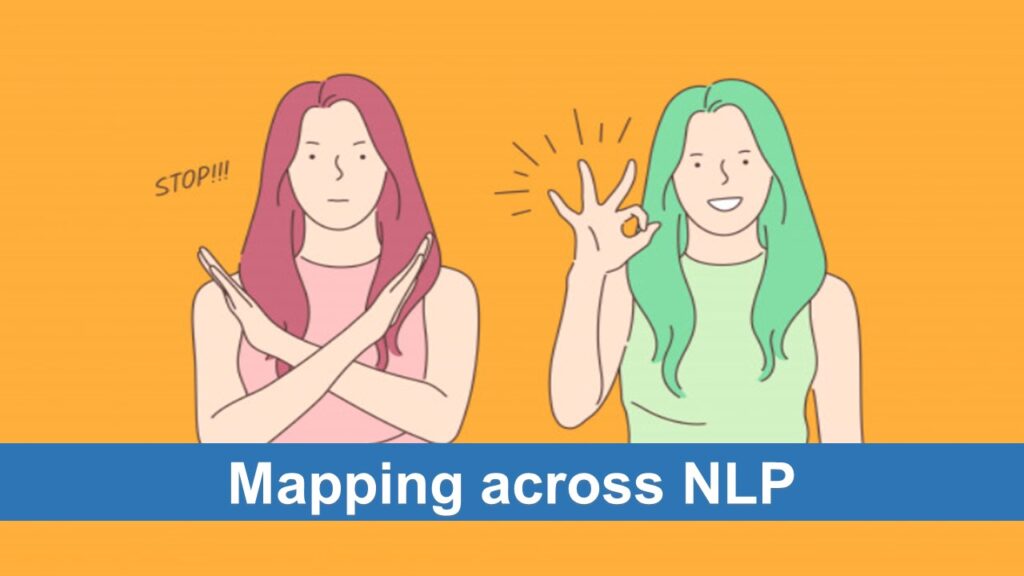Mapping across NLP techniques is also known as NLP-like to dislike technique, this process is a subtle way to change behavior and get desired results.
For best results with mapping across NLP technique, you are required to understand NLP Submodalities first and must have the checklist.
📘 Practical Applications of Neuro Linguistic Programming (9 book series)
Want ready-to-use NLP patterns at your fingertips?
👉 Grab your copies Now
When to use Mapping across NLP ?
The Mapping across NLP technique works well for changing internal state from one to another.
You can make yourself dislike something that you like the most and vice versa.
For Example
Let’s say you like one particular chocolate more and tend to eat it regardless of the bad effect of sugar on your health.
You can control your urge to eat anything but when this chocolate is there you can hold.
We can use mapping across NLP to get desired behavior of not controlling the urge to eat that chocolate or dislike it permanently.
Remember, as we understand from ecology check, we need to work on a particular brand of chocolate only. You should not play with a whole food group.
Mapping across NLP can be useful for habits like nail biting, shaking legs or any other unconscious behavior we tend to do.
You can change your liking and disliking with help of mapping across NLP and NLP submodalities.
Mapping Across NLP Process
Mapping across NLP process is simple provided you have practiced NLP submodalities, get your checklist from here.
Step 1
Choose an undesired behavior you want to change and choose a desired behavior you want instead.
Step 2
Now take first undesired behavior and with help checklist explore all representational systems.
Go in detail and understand all visual, kinesthetic, auditory, olfactory, and gustatory submodalities.
Ask questions with the help of the following table and note down.
| Visual | Auditory | Kinesthetic |
| Black & White or Colour Near or Far Bright or Dim Location Size of Picture Associated / Dissociated Focused or De-focused Framed or Unbounded Movie or Still If a Movie-Fast/Normal/Slow3 Dimensional or Flat Loud or Soft Internal or External Location | Stereo or Mono Fast or Slow High or Low Pitch Verbal or Tonal Rhythm Clarity Pauses Strong or Weak | Large Area or Small Area Weight: Heavy or Light Location Texture: Smooth or Rough Constant or Intermittent Temperature: Hot or Cold Size Shape Pressure Vibration |
Example of questions
“As you think about that, what do you see?”
“As you think about that, what do you hear?”
“As you think about that, what do you feel?”
“Is it near or far?”
“Is audio fast or slow?”
“Is the texture smooth or rough?”
Ask as many questions as possible and make a note of it.
Step 3
Take a break, ask the subject to move around or have a glass of water, or ask them something different than this exercise.
Step 4
Now take the desired behavior and with help checklist explore all representational systems.
Go in detail and understand all visual, kinesthetic, auditory, olfactory, and gustatory submodalities.
Ask questions with the help of the following table and note down.
| Visual | Auditory | Kinesthetic |
| Black & White or Colour Near or Far Bright or Dim Location Size of Picture Associated / Dissociated Focused or De-focused Framed or Unbounded Movie or Still If a Movie-Fast/Normal/Slow3 Dimensional or Flat Loud or Soft Internal or External Location | Stereo or Mono Fast or Slow High or Low Pitch Verbal or Tonal Rhythm Clarity Pauses Strong or Weak | Large Area or Small Area Weight: Heavy or Light Location Texture: Smooth or Rough Constant or Intermittent Temperature: Hot or Cold Size Shape Pressure Vibration |
Ask as many questions as possible and make a note of it.
Step 5
Now compare your notes for both desired and undesired behavior, try to find “Drivers” the forces that can make changes.
You may find desired behavior to have different attributes of visual, kinesthetic, auditory, olfactory, and gustatory submodalities than undesired behavior.
Mark down these differences.
Step 6
Now it is time to mapping across nlp, ask the subject to visualize undesired behavior again.
Gradually ask the subject to make changes in attributes of visual, kinesthetic, auditory, olfactory, and gustatory submodalities from your notes.
For example, ask them to increase brightness, dim the volume, change surface and so forth.
Step 7
Ask the subject to visualize undesired behavior with new changes we just made.
Hint, You can use NLP Anchoring technique here to make this change accessible in future.
Step 8
Do future pacing and check if change has been done, if not repeat the process a few times.
Mapping across NLP conclusion
You can use mapping across the NLP process to make small subtle changes, it may not be effective for complex behavior attributes.
You can use this technique for changing eating habits, likes or dislikes, but for complex habits like smoking you may need to club some other advanced techniques.
Reference – NLPU
